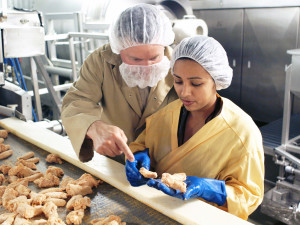What is “woody breast”? Is woody breast caused by bigger, faster-growing chickens?
“Woody breast” describes a quality issue stemming from a muscle abnormality in a small percentage of chicken meat in the U.S. This condition causes chicken breast meat to be hard to the touch and often pale in color with poor quality texture. Woody breast does not create any health or food safety concerns for people and the welfare of the chicken itself is not negatively impacted.
What causes “woody breast”? Is “woody breast” caused by bigger, faster-growing chickens?
The causes of “woody breast” are not known at this point, and researchers are working to determine causes and possible solutions. The poultry industry is funding more than a quarter of a million dollars on four separate research projects at independent universities and USDA’s Agriculture Research Service, while also working with geneticists, veterinarians and animal scientists to get to the bottom of this muscle condition and remediate it as soon as possible.
Does “woody breast” pose a threat to my health? Is it common?
No, chicken with “woody breast” poses no threat to consumers’ health. Concerns about “woody breast” lie in the quality of the meat (texture and appearance) but not the health or nutritional make-up of the meat. All chicken companies have personnel at the processing plant that inspect for these quality issues.
The condition is sporadic and affects a very small percentage of birds.
How are chicken producers responding to “woody breast?”
In addition to USDA Food Safety and Inspection Service (FSIS) personnel inspecting chicken for issues that would affect food safety*, chicken companies have employees in processing plants looking at every piece of breast meat for any quality issue. If “woody breast” is found, the meat is typically diverted.

The poultry industry is also funding more than a quarter of a million dollars on four separate research projects at independent universities and USDA’s Agriculture Research Service, while also working with geneticists, veterinarians and animal scientists to get to the bottom of this muscle condition. USDA researchers have already managed to differentiate chicken breasts with the woody breast condition from normal ones using imaging technology. In addition, University of Delaware researchers have identified the biomarkers, or genes, that characterize woody breast. Such research findings are expected to help advance new diagnostics and treatments for woody breast.
How are researchers responding to “woody breast”?
According to Dr. Casey Owens, of the University of Arkansas’s Center of Excellence for Poultry Science, “University researchers will continue to investigate the potential triggers of the development of this condition, along with evaluation of production practices that will help reduce the severity of woody breast. Ongoing research also includes evaluation of genes associated with the condition, developing biomarkers to predict the condition when animals are young. Other work includes developing remediation strategies for use of woody breast meat in processed products.”
*Learn more about how your chicken is inspected by visiting www.chickeninspectionfacts.com.
To download a PDF of this FAQ on woody breast, click here.
